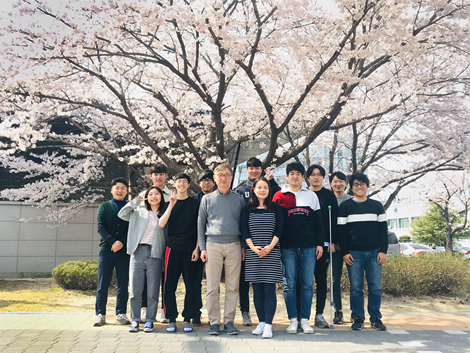CIVIL&ENVIRONMENTAL
ENGINEERING
WEBZINE2020 Vol.03, No.1All about Soil Dynamics Lab.
Research Goal-
- Our research group has made a continuous effort to understand site characterization by field and laboratory tests, offshore and earthquake geotechnical engineering problems via geotechnical centrifuge tests and seismic design of geotechnical structures. Through our research in geotechnical engineering, we aim to make our infrastructures safe and reliable for the future of our society by translating research ideas into real-field applications via design codes.
-
- Soil Dynamics Laboratory mainly focuses on understanding and solving geotechnical problems using physical modeling of geotechnical structures. For this, geotechnical centrifuge model tests are intensively used to get insights into real-field response of geotechnical structures during various loading scenarios. Using a geotechnical centrifuge, actual stress conditions encountered in the field can be reproduced in small-scale models by considering appropriate scaling laws, and any difference between field and laboratory response of geotechnical systems can be minimized. Various tests using the geotechnical centrifuge have been conducted to investigate both earthquake and offshore geotechnical problems.
- 1) Earthquake related problems
- 2) Offshore foundation related problems
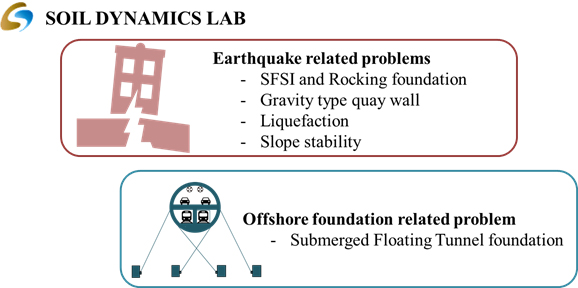
- In geotechnical engineering, it is important to describe the field- soil stress condition in laboratory tests because the behavior of the soil varies in confined stress. In order to replicate in-situ soil stress conditions to simulate prototype model behavior accurately in a model test, the geotechnical centrifuge facility was installed in collaboration with KOCED (Korea Construction Engineering Development). By spinning the centrifuge at high speeds, N-times centrifugal accelerations can be applied to the test model, which produces higher confined stress compared to the 1-g condition with a small-scale model.
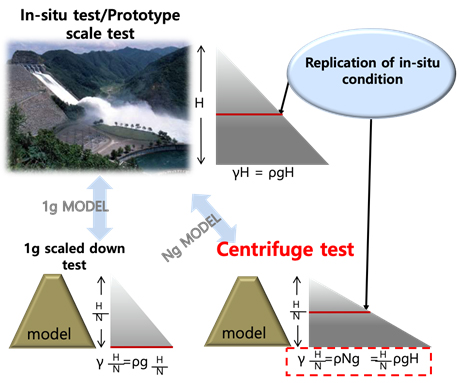
Concept of the geotechnical centrifuge test
- This facility houses a geotechnical centrifuge with a 5 m radius arm of which 4.5 m is the effective radius, and a maximum capacity of 240g-ton. It has a flat basket with a dimension of 1.2m × 1.2m × 1.2m (width × length × height). The centrifuge can be equipped with a self-balancing earthquake simulator (shaking table).
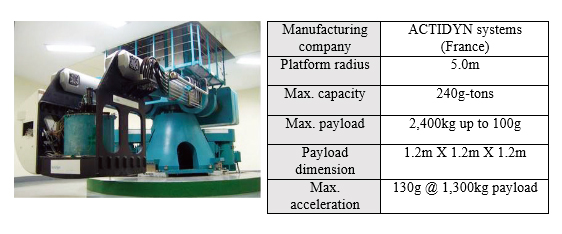
- The self-balancing earthquake simulator can load the test models with sinusoidal and real recorded earthquake motions while the centrifuge is spinning. It can apply loading intensity up to 0.5g in the prototype scale. The allowable frequency range of the input load is from 20 Hz to 300 Hz in the model scale.
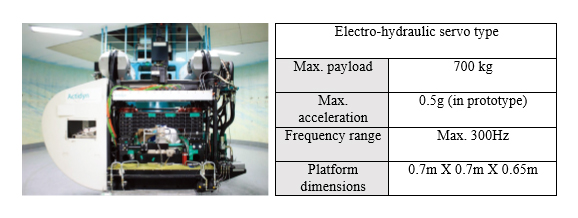
- 1) Rocking Foundation
-
-
The use of the rocking behavior of shallow foundation, called rocking foundation, has emerged as an effective seismic design for shallow foundation to reduce the seismic load on the structure. The rocking mechanism for the embedded shallow foundation is investigated in our laboratory.
The details of rocking foundation which are investigated in our facility are described as follows: (1) soil rounding effect on embedded shallow foundation via horizontal slow cyclic tests; (2) comparison between cyclic and dynamic rocking behavior for embedded shallow foundation considering structural flexibility; (3) centrifuge modeling of improved design for rocking foundation using short piles.
-
The use of the rocking behavior of shallow foundation, called rocking foundation, has emerged as an effective seismic design for shallow foundation to reduce the seismic load on the structure. The rocking mechanism for the embedded shallow foundation is investigated in our laboratory.
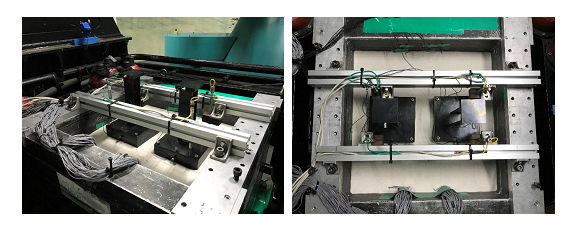
Photos of dynamic centrifuge tests for rocking foundation problems
- 2) Gravity type quay wall
-
-
The collapse of the quay wall installed in the port can cause human casualties and economic damage. In particular, damage from unexpected natural disasters such as earthquakes is serious. Therefore, it is necessary to study the performance of the quay wall during an earthquake event. To apply the performance-based design to the quay wall, the seismic performance verification methods for the quay wall were improved in our laboratory using the geotechnical centrifuge.
The research in quay wall carried out in our laboratory is described as follows: (1) improvement of the seismic coefficient for limit-equilibrium based design; (2) improvement of the seismic coefficient for performance-based design; (3) verification of performance of gravity type quay wall using a retaining wall.
-
The collapse of the quay wall installed in the port can cause human casualties and economic damage. In particular, damage from unexpected natural disasters such as earthquakes is serious. Therefore, it is necessary to study the performance of the quay wall during an earthquake event. To apply the performance-based design to the quay wall, the seismic performance verification methods for the quay wall were improved in our laboratory using the geotechnical centrifuge.
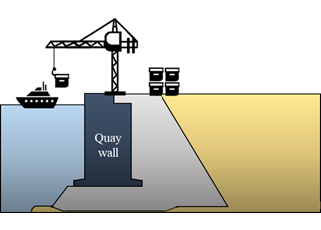
Schematic view of the retaining wall
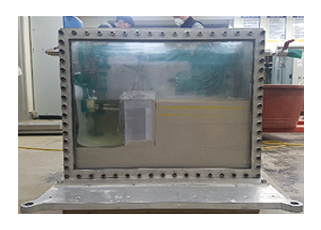
Test modeling of gravity type quay wall
- 3) Liquefaction
-
-
Soil liquefaction occurs when a saturated soil substantially loses strength and stiffness in response to an applied stress such as shaking during an earthquake or other sudden change in stress condition, in which material that is ordinarily a solid behaves like a liquid.
In order to analyze the liquefaction problem in detail, the physical and numerical modeling of liquefaction are important. For this reason, our laboratory joined the Liquefaction experimental and analysis project (LEAP), which is an international collaborative project to simulate the liquefaction of the ground by physical and numerical modeling in 2016. Furthermore, our laboratory launched a project to develop design guidelines for liquefaction suitable to Korean soil conditions in 2019.
-
Soil liquefaction occurs when a saturated soil substantially loses strength and stiffness in response to an applied stress such as shaking during an earthquake or other sudden change in stress condition, in which material that is ordinarily a solid behaves like a liquid.
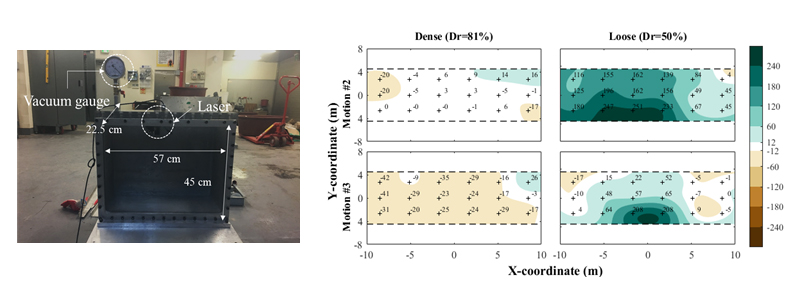
Centrifuge tests and test results for LEAP (2017) tests
- The studies for liquefaction conducted in our laboratory are described as follows: (1) development of centrifuge testing system for modeling liquefaction; (2) development of Korean guidelines for identification, assessment, and mitigation of liquefaction hazards
- 4) Slope stability
-
-
Most research related to free-field ground response during earthquakes has been focused on the flat ground. However, in mountainous areas, it is important to understand the behavior of slopes during earthquakes because the response of inclined sloping ground during earthquakes could be different than flat ground condition. Therefore, our research group conducted centrifuge model tests to understand the dynamic behavior of slopes during earthquakes.
The subjects related to slope stability during earthquakes are described as follows: (1) influence of the earthquake frequency on the slope; (2) evaluation of the deformation of the model slope by a strong earthquake; (3) amplification of the earthquake motion in slopes.
-
Most research related to free-field ground response during earthquakes has been focused on the flat ground. However, in mountainous areas, it is important to understand the behavior of slopes during earthquakes because the response of inclined sloping ground during earthquakes could be different than flat ground condition. Therefore, our research group conducted centrifuge model tests to understand the dynamic behavior of slopes during earthquakes.
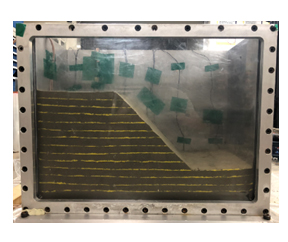
Slope stability model tests
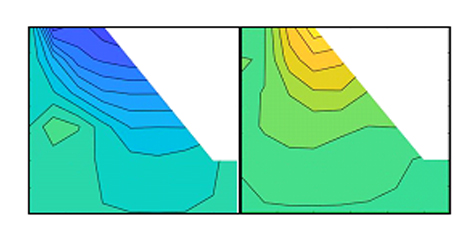
Reflections and superposition of the earthquake motion at the slope crest
- 1) Submerged floating tunnel (SFT) foundation
-
-
Standardization of design and analysis protocols for anchorage-foundation system considering the submerged ground condition are critical. This research will focus on developing core technologies needed for the construction of smart submerged infrastructure at state-of-the art level, ensuring smartness, safety, economic-viability, and construction-ability.
The research related to SFT foundation system is described as follows: (1) foundation-anchor system for supporting submerged floating tunnel; (2) foundation design considering ground condition (Suction anchor and modified suction anchor for sand, Gravity anchor for clay, Drilled pile shaft for rock conditions, and Hybrid foundation systems); (3) assessment of foundation system behavior under various loading condition (Buoyancy of SFT and environmental loads including cyclic loadings); (4) parametric studies of anchor foundations for SFT using commercial numerical analysis program.
-
Standardization of design and analysis protocols for anchorage-foundation system considering the submerged ground condition are critical. This research will focus on developing core technologies needed for the construction of smart submerged infrastructure at state-of-the art level, ensuring smartness, safety, economic-viability, and construction-ability.
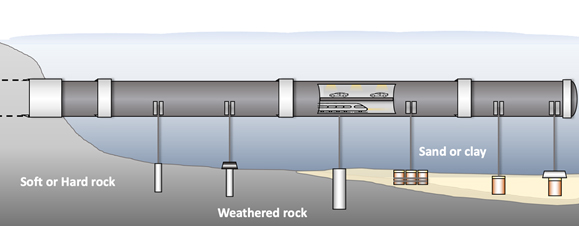
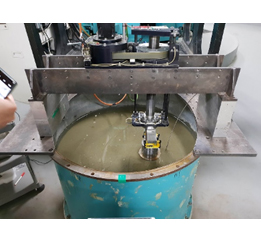
Suction anchor centrifuge test
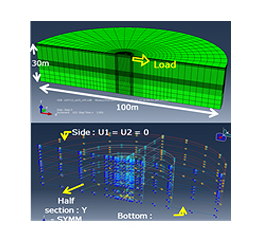
Numerical analysis for suction anchor(Su-Rin Kim, 2016)
-
- Soil dynamics lab applies experimental, numerical, and theoretical approaches to earthquake and offshore foundation related problems.
